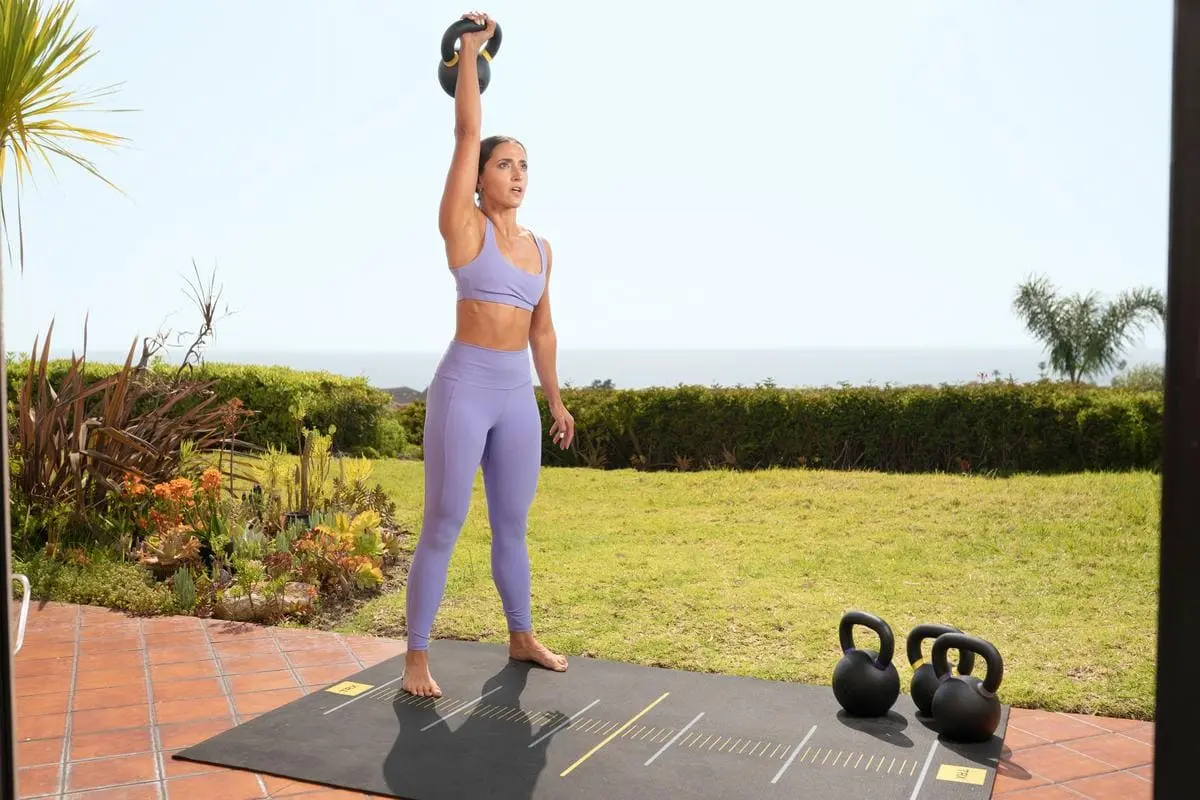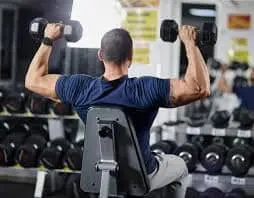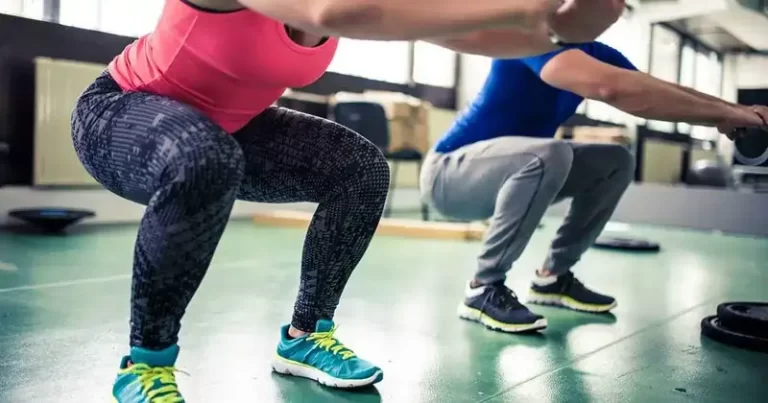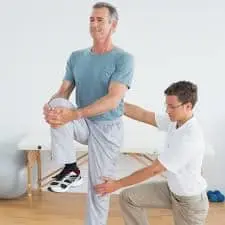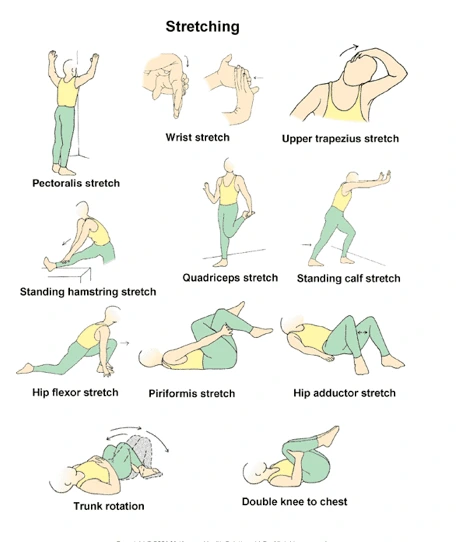21 Best Kettlebell Exercises
Kettlebells are a well-liked alternative to conventional barbells, dumbbells, and resistance machines in strength training.
Introduction:
If you’re feeling a little tired with your usual dumbbell workouts, we could suggest including some Kettlebell Exercises. Changing up your load can breathe new life into your program and open up a world of possibilities to fit into whatever routine you may have.
This is because kettlebells are a very useful piece of equipment. For this reason, they are great instruments to increase the difficulty of your full-body, lower-body, or upper-body workouts.
For certain weighted exercises, kettlebells work well, especially when the movements are fast. Their linked handle and rounded bell-bottom form also make them easier to move around.
Additionally, because your range of motion will be slightly varied, you will also see variations in the performance of your muscles when you grab them from above. However, choosing which workouts to perform with kettlebells can be unsettling if you’ve never used them before. As a result, we put together a list of the best Kettlebell Exercises that engage every muscle in your body.
What is the ideal weight for a kettlebell?
Your degree of strength and equipment knowledge are two important elements that will affect the weight of the kettlebell you utilize. (Similarly, beginners should start with bodyweight exercises until they feel comfortable doing the movements with proper form.)
However, a kettlebell weighing ten to fifteen pounds is a suitable place to start. You can start with a kettlebell that weighs 20 pounds or more if you are more seasoned in weightlifting and feel comfortable working with heavier weights.
Furthermore, it’s important to keep in mind that the exercises you do with kettlebells define what weight is “suitable” for them. For example, you might be able to lift more weight with a deadlift because it works greater muscles than a triceps extension, which works smaller muscles.
What advantages may kettlebell exercises provide?
When compared to other weights like dumbbells or plates, the kettlebell has a different form. It appears to be a handle-equipped ball.
- Improves Stability and Balance
Strengthening your balance with kettlebell exercises will help you stay stable and avoid falls as you age. The aging process affects the muscles, joints, and bones.
- A Type of Strength and Cardio Exercise
Kettlebell exercises increase muscular mass and heart rate while improving strength and cardiovascular fitness. Just as much as high-intensity interval running, kettlebell exercise has the potential to increase aerobic capacity.
Best Kettlebell Exercises:
Turkish Get-Up
- Your arms and legs should be extended at a 45-degree angle while you lie on your back in the starting posture.
- Put your right foot level on the ground and flex your right leg just a few inches outside of your hip and away from your butt.
- With your right hand, make a fist and point your knuckles straight up toward the ceiling as you raise your right arm straight up toward the ceiling.
- Keep your wrist from bending back.
- Eventually, the kettlebell will land in your fist, so focus on that.
- Then, to raise yourself onto your left elbow, push through your right heel and your left elbow.
- This is how your left shoulder should be positioned.
- Putting together your shoulder involves first rounding it forward and then forcing your arm through the floor to pack it down and away from your ears in the opposite direction.
- Face the wall in front of you with your chest instead of the ceiling.
- Laying your left palm on the floor, pressing into it, and using your abs to pull your body in, is how you sit.
- Make sure your left shoulder is firm at all times.
- To extend your elbow away from you and rotate your fingertips slightly back behind you, try pressing your palm into the ground.
- Following that, go your left leg beneath you and in the direction of your butt, aligning your left ankle and knee with your left hand.
- The distance from your left knee to your left hip should be the same as the length of your body, and your left knee should be positioned squarely underneath your left hip.
- If you need to make any adjustments, move your knee, not your hand.
- Move your weight back toward your left heel from this position.
- Put yourself in a half-kneeling, open position.
- Both your “up” and “down” knees should be 90 degrees and pointed in the same direction to the left and straight forward, respectively.
- Now, bring your left leg (down knee) behind you to the left so that it is facing straight ahead of you, then extend your legs into a half-kneeling (or lunge) position.
- Now you ought to be facing directly ahead.
- To bring your feet together and stand, concentrate on strengthening your core, getting nice and strong, and pressing your back foot into the ground.
- Then return to your neutral position.
- Then relax.
- Repeat this exercise six to twelve times.
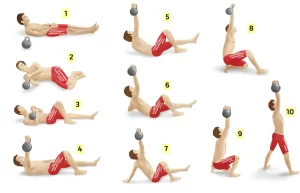
Kettlebell Halo
- Start with a relaxing standing position.
- The shoulders ought to be loose and positioned above the hips.
- The knees should remain straight and sturdy, not locked or stiff.
- Gripping the handle’s vertical sides, or the horns, hold the kettlebell in front of your body.
- The kettlebell’s ball or bottom should be facing up, while the handle should be facing down.
- Turn to the right to start.
- Lift and rotate the kettlebell around your head to the right, then release it behind your neck.
- On the left side of your head, finish the circle by going back to the starting point.
- You’re going to want to touch your hair as you turn around, and you’ll be reaching for it.
- Turn around after you’ve completed one full rotation.
- Starting from the left, complete the circle by turning around and returning to the starting point on the right.
- Then return to your neutral position.
- Then relax.
- Repeat this exercise six to twelve times.

Kettlebell Sumo Squat
- With your feet roughly shoulder-width apart and your toes pointing forward, begin in the standard squat position.
- Put your hands together at your chest.
- Step out to the right with your right foot until your stance is three to four feet wide, or broader than the depth of your hips.
- If you can do the movement correctly, wider is okay.
- Rotate your hips laterally to angle your toes outward and away from your body’s center, around 45 degrees.
- Bend your knees and gently realign your hips as you lower yourself into a squat position.
- Take a straight line to the floor with your buttocks.
- Throughout the exercise, pay attention to maintaining your eyes forward, your core active, and your spine neutral.
- After you bring your thighs level to the ground’s surface, lower yourself.
- If you can’t keep your legs aligned or if the parallel is too low, you can shorten or lower the squat.
- Hold this position for a few seconds.
- After that, press up through your heels while using your glutes to press yourself up to standing.
- Then return to your neutral position.
- Then relax.
- Repeat this exercise six to twelve times.
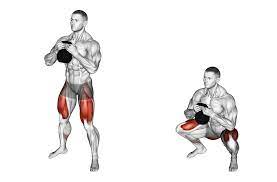
Kettlebell Triceps Extension
This workout targets the muscles at the back of your upper arms, or your triceps. Your back should be straight, not arched, to guarantee that your triceps are performing all the work.
- Hold the kettlebell at chest height with both hands by the horns, bell facing up.
- Take a step forward with your left foot and take a tall posture.
- To keep your back foot flat on the ground, you can either point your right toe out or come up on your toes.
- Maintaining a bent hip and an engaged core will help you press the weight above.
- Keep your arms raised and your elbows firm as you drop the kettlebell behind your head by straightening at the elbows.
- Hold this position for a few seconds.
- To shift the weight and get back to the beginning position, extend your arms straight.
- Then return to your neutral position.
- Then relax.
- Repeat this exercise six to twelve times.

Row of Chainsaws
- Begin a split stance with the kettlebell on the ground.
- Maintain the body position low and pull with your elbow as you quickly row the bell.
- Hold this position for a few seconds.
- Before attempting the next repetition, place the kettlebell back on the floor and give it a moment to rest.
- Then return to your neutral position.
- Then relax.
- Repeat this exercise six to twelve times.

Kettlebell Glute Bridge
- Place your feet level on the floor, hip-width apart, and lie on your back with your knees bent.
- A kettlebell should be held by its handle, just over your hip bones.
- Contracting your glutes and core, together with pushing through your heels, will raise your hips a few inches off the ground and create a straight line in your body from your shoulders to your knees.
- Hold this position for a few seconds.
- Then return to your neutral position.
- Then relax.
- Repeat this exercise six to twelve times.
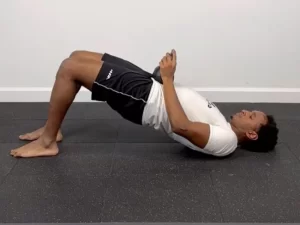
Kettlebell Single-Arm Row
- Spread your feet hip-width apart when standing.
- Grasp a kettlebell by its handle with your small right hand.
- With your core engaged, push your butt back, bend your left knee, and tilt forward at the hips without rounding your shoulders.
- The flexibility and range of motion in your hips and hamstrings affect how easily you can bend over.
- Look down at the ground a few inches in front of your feet to keep your neck in a comfortable position.
- Pull the weight up to your chest, keeping your elbows close to your body, and squeeze your shoulder blade at the top of the movement.
- Your elbow will reach your back as you bring the weight up to your chest.
- Hold this position for a few seconds.
- The weight is progressively released as you reach for the floor with your arms.
- Then return to your neutral position.
- Then relax.
- Repeat this exercise six to twelve times.
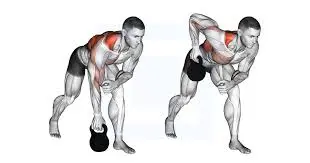
Kettlebell Single Leg Deadlift
- By keeping your feet hip-width apart and using your core, you can keep your spine neutral. Keep your knees slightly bent.
- With one leg extended straight behind you, move your weight to the other while keeping your foot contracted.
- Furthermore, take a bending hip position and use your free hand to reach down and grasp the kettlebell handle in a neutral posture.
- Maintain a straight back and lowered shoulders.
- Lower your body and the kettlebell towards the floor gradually while maintaining a long spine and extending your leg parallel to the floor.
- Hold this position for a few seconds.
- Your hamstrings and glutes ought should feel stretched.
- To align your body, contract your glutes and push into your standing leg.
- Keep the kettlebell close to your body during the entire workout.
- Then return to your neutral position.
- Then relax.
- Once you have completed the required number of repetitions on one leg, switch legs and do the activity on the other side.
- Repeat this exercise six to twelve times.
- Repeat with the opposite side.
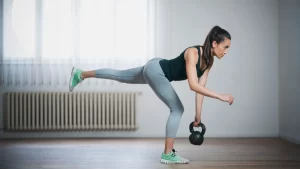
Kettlebell Swing Two Hands
- Push your hips back and down while keeping your shoulders down and your back straight.
- Using your hamstrings and glutes as the starting points, “hike” the kettlebell back a little bit between your legs at the same time.
- Bring your hips forward when the kettlebell reaches its lowest point.
- To raise the kettlebell higher, flex your abs and core.
- Maintain a straight back while standing tall and extending your hips.
- The kettlebell should naturally rise to chest height with a momentum, so you shouldn’t need to pull it with your arms.
- Allow the kettlebell to swing controllably back between your legs as you prepare for the next repetition, then hinge again at the hips.
- Keep swinging in a smooth, rhythmic manner, focusing on using your hips and core to push the movement.
- Then return to your neutral position.
- Then relax.
- Repeat this exercise six to twelve times.

Kettlebell Goblet Squat
- Position yourself such that your feet are slightly wider than hip-width apart and your toes are slightly pointing out.
- Grasp a kettlebell at your chest level.
- If you find it more comfortable to hold it by the handles, you can alternatively carry it by the bell.
- As you lower yourself into a squat, push your hips back, compress your core, and shift your weight into your heels, keep your chest up and your back flat.
- Next, squeeze your glutes after pushing through your heels.
- Hold this position for a few seconds.
- Then return to your neutral position.
- Then relax.
- Repeat this exercise six to twelve times.
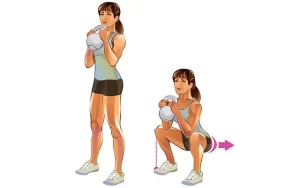
Kettlebell Romanian Deadlift
Kettlebell deadlifts are among the top workouts for strengthening the lower body using kettlebells. You may strengthen your hamstrings and the backs of your legs by performing deadlifts. They also gently challenge your core since you need to keep your abs firm to avoid arching your back.
- Gently bend your knees and place your feet hip-width apart.
- Press a kettlebell between your thighs with both hands, palms facing inward.
- Lean your hips and push your butt back as you drop your body and the weight towards the floor.
- At the bottom of the exercise, your body should be almost parallel to the floor.
- Hold this position for a few seconds.
- To stand up straight and keep your arms in a straight position, push through your heels with a strong core.
- Then return to your neutral position.
- Then relax.
- Repeat this exercise six to twelve times.
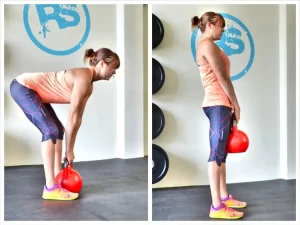
Kettlebell Thrusters
- Two kettlebells should be held by their handles while your weight is supported by your back.
- Knee slightly bent, bend down while keeping your legs parallel to your shoulders.
- Elevate the kettlebells over your head by lifting through and straightening your legs, and then spreading out with your arms.
- Hold this position for a few seconds.
- Then return to your neutral position.
- Then relax.
- Repeat this exercise six to twelve times.

Sit-Up to Press-Up
Adding weight to a sit-up strengthens your core and tones your arms and shoulders at the same time. Whatever your hips feel comfortable with.
- Grasp a kettlebell with both hands at your chest while lying comfortably with your legs bent and your feet flat.
- That’s where everything begins.
- Your back should be straight as you sit up straight, therefore use your abs to lift your body up.
- At the same time as you press the weight overhead, extend both arms until your elbows are straight.
- Hold this position for a few seconds.
- Then return to your neutral position.
- Then relax.
- Repeat this exercise six to twelve times.
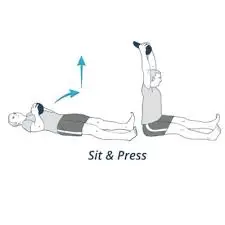
Kettlebell Overhead Press
- Standing, position your feet hip-width apart.
- Hold a kettlebell by the handle in each hand at your shoulders, with your elbows bent and your palms pointing inward.
- With your elbows extended to their maximum length and your hands turned palms out, lift the dumbbells overhead.
- A strong core and curled hips will help you avoid arching your lower back when you raise your arms.
- Hold this position for a few seconds.
- Gradually bend your elbows to move the weight back to its starting point.
- Then return to your neutral position.
- Then relax.
- Repeat this exercise six to twelve times.
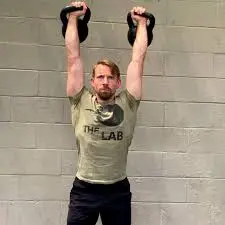
Kettlebell Clean and Press
- Take a position with kettlebell by your thighs, with your legs shoulder-width apart and your knees slightly bent.
- Take a small leap off the ground and quickly raise your arms above your head.
- Raise your arms straight up above your head, shoulder-width apart, while gently planting your feet and bending your knees slightly in a squatting motion.
- Hold this position for a few seconds.
- Then return to your neutral position.
- Then relax.
- Repeat this exercise six to twelve times.
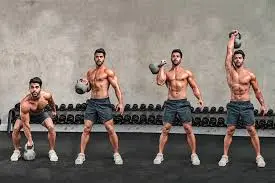
Kettlebell Slingshot
- Select a weight for the kettlebell that is difficult yet practicable.
- Use less when you first begin the exercise regimen.
- As you stand, place your feet shoulder-width apart and point your toes slightly out.
- While tensing your core, keep your back straight.
- Grip the kettlebell near the bottom of the handle with both hands, in front of your thighs.
- To begin, swing the kettlebell between your legs and allow it to land between your knees.
- Keep your arms in a straight position.
- As it rises slightly behind you, strongly swing the kettlebell up and around the outside of your right hip.
- Rotate your shoulders and body to generate force.
- At the highest point of the movement, swing the kettlebell to your left hand, passing it over your chest and under your right arm.
- Throughout the exercise, try to maintain the straightest possible arm posture.
- Continue swinging the kettlebell around your left hip and under your left arm, then into your right hand.
- Try to keep your hips moving and your core active with an easy, rotating motion.
- Then return to your neutral position.
- Then relax.
- Repeat this exercise six to twelve times.
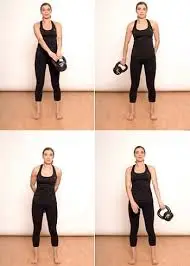
Kettlebell Swing
- Place your feet shoulder-width apart and grasp a kettlebell in each hand.
- Let the kettlebell swing back between your legs by bending your knees slightly and pushing at the hips.
- The kettlebell is pushed forward and up to chest height by applying pressure to your heels, contracting your glutes, engaging your core, and driving your hips forward.
- Hold this position for a few seconds
- Allow it to drop back between your legs organically. That is an example of repetition.
- Then return to your neutral position.
- Then relax.
- Repeat this exercise six to twelve times.

Kettlebell Pistol Squat
- Using both hands, grasp one kettlebell slightly behind your chin.
- Extend one leg off the floor and lower the other into a squat.
- Hold this position for a few seconds.
- To go back to standing, push through your heel without letting your leg touch the ground.
- Then return to your neutral position.
- Then relax.
- Repeat this exercise six to twelve times.
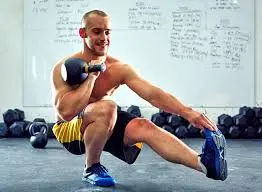
Kettlebell Single-Handed Swing
- Push your hips back while maintaining a straight back and lowered shoulders.
- While maintaining your arm engaged, similarly “lift” the kettlebell back between your legs a little bit using your hamstrings and glutes.
- As the kettlebell reaches its lowest point, quickly push your hips forward.
- To raise the kettlebell higher, tighten your core and glutes.
- Maintain a straight back and an upright position with expanded hips.
- Focus on using your hips and core to generate force instead of your arms.
- As the kettlebell picks up speed, it should naturally rise to chest height.
- Allow the kettlebell to swing back between your legs under control as you prepare for the next repetition, then hinge at the hips once more.
- Then return to your neutral position.
- Then relax.
- Repeat this exercise six to twelve times.
- After performing as many repetitions as possible on one side, carefully move the kettlebell to your other hand and carry out the workout there.
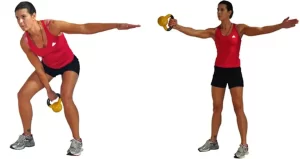
Kettlebell Split Squat
The split squat works your quads and glutes similarly to a goblet squat, but because it puts you in a lunge position and requires more effort from your front leg, it’s considered a unilateral exercise. However, balancing won’t be as difficult as it would be in a regular lunge because you aren’t pushing forward.
- Place both hands at your chest to grasp a kettlebell.
- Keeping your left heel firmly planted with your feet beneath your shoulders, step your left foot forward as though you were completing a forward lunge.
- Bend both knees so that your legs form a 90-degree angle.
- Your chest should be straight and your body positioned somewhat forward to guarantee that your back is flat and not rounded or arched forward.
- You should have your left knee over your left foot and your left quadriceps parallel to the floor.
- Hold this position for a few seconds.
- Use your core and butt and Push through your left foot to return to the starting position.
- Then return to your neutral position.
- Then relax.
- Repeat this exercise six to twelve times.
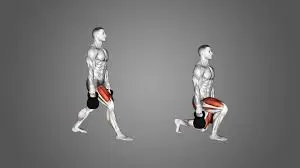
Kettlebell Chest Press
Pressing exercises are a great way to build your pectorals, or chest muscles, which is a key component of any comprehensive fitness program. Together with your pecs, this workout will work your triceps.
- Place your feet flat on the floor and bend your knees to lie down.
- With your hands evenly spaced and your palms pointing inward, take hold of a kettlebell with your elbows slightly bent on the ground.
- This is the starting point of everything.
- As you press the weights toward the sky, keep your hands pointed inward and extend your elbows fully.
- Hold this position for a few seconds.
- Slowly bend your elbows and then put them back on the ground.
- Then return to your neutral position.
- Then relax.
- Repeat this exercise six to twelve times.
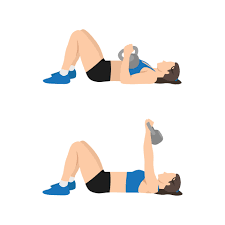
Safety factors:
Exercises using kettlebells require care to lower the chance of damage.
Here are some guidelines for safety to take;
- If you’re new to exercising, gradually increase the number of repetitions and sets you perform in kettlebell exercise sessions.
- As you gain strength and comfort with the exercises, start with a lesser kettlebell and work your way up to a heavier one.
- Wear loose-fitting attire. Put on supported, non-slip shoes that preserve the arches of your feet.
- Don’t perform kettlebell workouts two days in a row to give your muscles a chance to heal.
- As you lift and swing the kettlebell, move smoothly. Avoid locking your legs or arms.
- Don’t forget to warm up and cool down with five to ten minutes of light aerobic activity before and after each session.
Summary:
Workouts using kettlebells are an excellent method to combine strength and cardio training. Kettlebells are weights with handles that are used to work different muscle groups by lifting or swinging weights. There are numerous kettlebell workouts available. To avoid injuries, make sure you use a kettlebell properly, which includes choosing a weight that is suitable for you. With this weight, you may work out different body regions in a variety of ways, such as your core with kettlebell Exercises.
The key is to begin slowly and, if possible, with the help of a qualified personal trainer. Once you can perform the exercises with good form with a lighter weight, you can advance to using a larger weight and increase your repetitions and sets.
FAQ:
Do kettlebell exercises work?
As with dumbbells, kettlebells are an effective tool for strength training since you can use them to gradually test your muscles by increasing the weight or the number of repetitions.
What is the daily number of kettlebell workouts performed?
Your degree of fitness and your goals, which could include improving your vertical leap or deadlift, explosive power, or endurance, will be key factors in this. To begin, include three to five sets of ten to twenty kettlebell swing repetitions into your regular training regimen.
Which kettlebell workout targets the most muscle groups?
Because they work your entire body and demand a lot of strength, kettlebell thrusters rank among the best workouts you can do with a kettlebell. Start by gripping two kettlebells by the handles and placing the weight on your back shoulders to perform a thruster.
Can I lose weight with only kettlebells?
You can add specific kettlebell movements to your fitness regimen or use them alone to generate a full-body workout. Your overall health and the type of workout you’re doing are two more elements that could affect the kettlebell weight you choose.
Are kettlebells safe to use every day?
Overuse of kettlebells might have hazards despite their many benefits. The likelihood of overtraining syndrome increases with daily exercise. Your ability to perform may decline, and a variety of health problems such as persistent fatigue and sprains and strains may appear.
Does ten minutes of kettlebell training be enough?
You may work out with kettlebells for 10 minutes and challenge your cardio while using every muscle in your body.
What kind of body can you expect from a kettlebell?
Exercises with a kettlebell increase the amount of strong muscle tissue in your body, making you appear more firm, more muscular, and more toned. Your body produces thicker muscular tissue while burning fat, making your muscles appear tighter and your body appear slimmer.
Do kettlebells help people lose tummy fat?
By building muscle and boosting the calories you burn off through exercise each day, kettlebell swings can help in weight loss. Although kettlebell swings cannot specifically target belly fat, they can help in overall body fat loss, eventually leading to belly fat loss.
To whom should kettlebell swings be avoided?
Kettlebell swings are not recommended for anyone with herniated discs or back problems.
References:
- August 11, 2023: Brookes, G. 52 Kettlebell Workouts for Both Men and Women. Greg Brookes: Kettlebell Workouts. https://kettlebellsworkouts.com/workouts-with-kettlebells/
- R. Sharma (2024, Jan. 5). For every fitness level, here are the top 31 kettlebell exercises. Mobile Clinic for Physiotherapy. Best Kettlebell Exercises: https://mobilephysiotherapyclinic.in/
- May 19, 2024; Frazier, R. S. The Top 6 Kettlebell Workouts for the Whole Body. wellness. Exercise with kettlebells at https://www.health.com/fitness
- May 21, 2024; Roland, J. Make Time for These 7 Kettlebell Workouts in Your Exercise Program. The website Healthline provides information about exercise, fitness, and kettlebell workouts.
- Image 2, M. Koban (2020, Dec. 4). The Kettlebell Halo 20kg Green Kettlebell is available at https://martinkoban.com/cardio-exercises-pain/kettlebell-halo-20kg-green-kettlebell/. Martin Koban
- Image 4, BodBot. [n.d.]. http://www.bodbot.com/Exercises/1006/Kettlebell-Tricep-Extension-_-Standing,-One-Arm
- Image 5, Whether you’re working out in the gym, outside, or both, our big workout will leave your entire body exhausted. (18 August, 2021). male health. Great workout for building muscle. https://www.menshealth.com/uk/workouts/a36208446/
- Image 7, Lift Instructions. (2023, April 24). Directions, Benefits, and Practice for the Kettlebell Single Arm Row. kettlebell one-arm row: https://liftmanual.com/
- Image 8, December 15, 2023: Downey, J. This is what happened to my body after a week of doing kettlebell single-leg deadlifts every day. The Guide of Tom. They practiced kettlebell single-leg deadlifts at https://www.tomsguide.com/features every day for an entire week. My physical appearance reacted in this way.
- Image 11, On October 2, 2019, Lefkowith, C. Work Your Backside Using The Deadlift. Strength Redefined. https://the-deadlift.redefiningstrength.com/
- Image 12, Botond, B. (2017, May 10). Kettlebell Thruster How To Exercise Guide. https://get-strong.fit/Kettlebell-Thruster-Exercise-Guide/Exercises#google_vignette
- Image 13, Skimble.com. Kettlebell Sit & Press (n.d.). This is an example of how to perform the 34000-kettlebell-sit-press exercise on Skimble.com.
- Image 14, Zack & Zack. January 14, 2024. Zack Henderson Fitness: The Complete Guide to the Kettlebell Press. Fitness Zack Henderson -. The Ultimate Kettlebell Press Guide, available at https://zackhenderson.com/
- Image 15, June 6, 2022, DMoose. DMoose’s Kettlebell Clean & Press Exercise Guide Will Give You Explosive Power. The kettlebell clean-press exercise is a popular post on the Dmoose blog.
- Image 16, (2020, August 20). Fit. These 22 Kettlebell Workouts Will Make You Feel Like A Boss. Exercises, Training Plans, and Workouts. 22 kettlebell exercises at FitMw.com
- Image 18, How to Perform Properly and Work Your Muscles with Kettlebell Pistol Squats? (As of now). Kettlebell Pistol Squats: Home Workouts, https://homeworkouts.org/exercise/
- Image 19, On July 9, 2024, Ascm-Cep, L. W. M.Kettlebell Swings: Proper Form, Modifications & Frequent Mistakes. incredibly comfortable. https://www.verywellfit.com/kettlebell-swing-techniques-benefits-variations-8691529
- Image 20, D. Luna (2023b), May 29. The benefits, muscles used, and more of the kettlebell split squat. Motivate US. The kettlebell split squat is available at https://www.inspireusafoundation.org.
- Image 21, L. Putra (n.d.–b). A woman uses one arm to do a kettlebell floor press workout. A flat vector artwork featuring an isolated workout character set on a white background. The graphic titled “Woman Practicing One Arm Kettlebell Floor Press Workout Flat Vector Illustration Isolated on White Background Workout Character Set” was discovered by Vecteezy.

